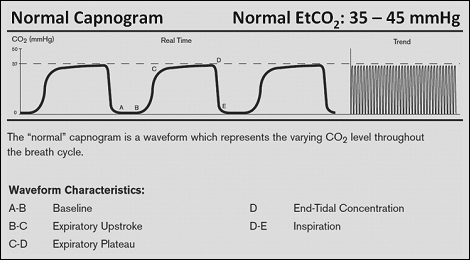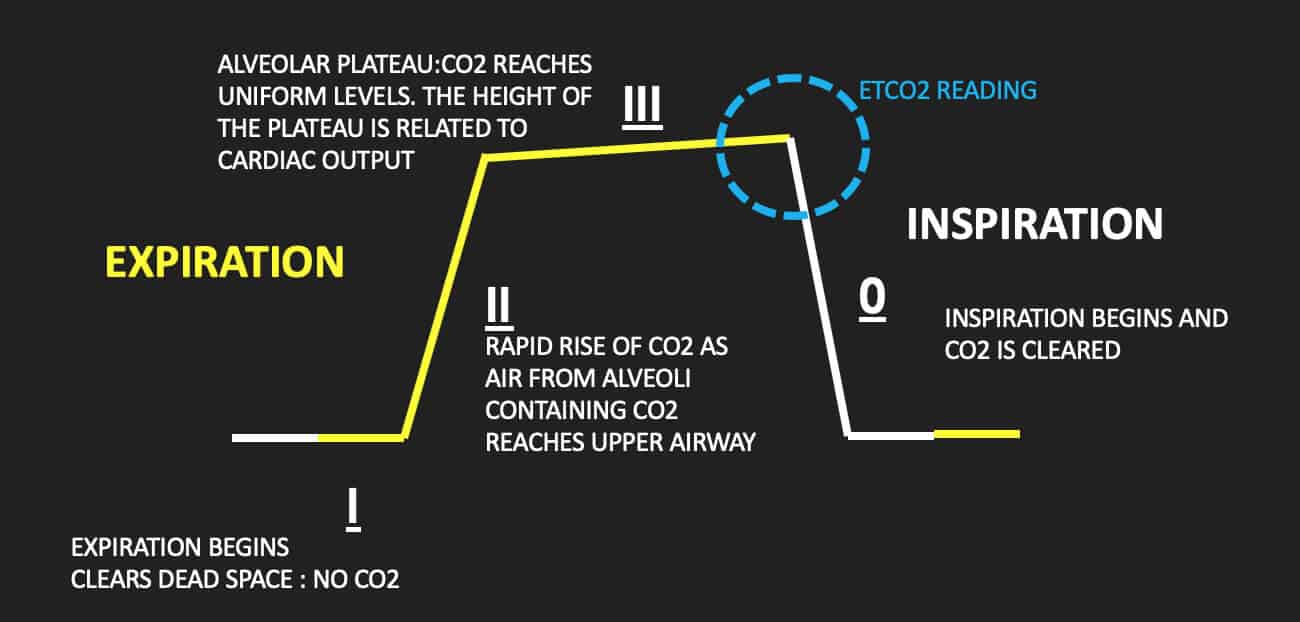end tidal co2 range
End Tidal CO 2 sampling Ventilatory function minute ventilation decreases and therefore CO2 increases in a A dead space gasno CO2 B mixed gasrising CO2 C alveolar gasCO2 plateau D inspiration no CO2 The monitor will continuously read the CO2 level in or mm Hg and display the peak CO2 value ETCO2 and respiratory rate. In this study the aim was to review the applications of end-tidal carbon dioxide ETCO2 monitoring in emergency department multiple databases were comprehensively searched with combination of following keywords.

The Impact Of Ventilation Rate On End Tidal Carbon Dioxide Level During Manual Cardiopulmonary Resuscitation Resuscitation
In other words a high ETCO2 is a good sign of good ventilation while a low ETCO2 is a sign of hypoventilation.

. The ETCO2 is the amount of carbon dioxide CO2 exhaled from ventilationd air. ETC02 monitoring may be discontinued when. 78 Nitrogen 21 Oxygen 1 CO2 and other gases Exhaled gases.
Waveform and end -tidal carbon dioxide EtCO2 values. When CO2 diffuses out of the lungs into the exhaled air a device called a capnometer. According to the book by Hockenberry and Wilson 2015 p 1140 normal values of ETCO2 are 30-43 mmHg which is slightly lower than arterial PaCO2 35-45mmHg.
What Is Appropriate Etco2. 6 hours after continuous epidural infusion is discontinued c. The number is called capnometry which is the partial pressure of CO 2 detected at the end of exhalation ranging between 35 - 45 mm Hg or 40 57 kPa.
Utility of end-tidal carbon dioxide detector during stabilization and transport of critically ill children. End Tidal CO 2 6 Can also be measured and monitored in spontaneously. In normal conditions CO2 is 5 to 6 which is equivalent to 35-45 mmHg.
Reading the Waves When it comes to capnography everyone knows the normal adult respiratory. It is best to get an ABG along side the end tidal to calculate the patients shunt. Accuracy of end-tidal PCO2 measurements using a sidestream capnometer in infants and children ventilated with the Sechrist infant ventilator.
The normal range of 35 to 45mmHg. MmHg Relate to the air we breath. End-tidal CO2 may be useful here as an easily and immediately measurable index of changes in cardiac output.
The presence of a normal waveform denotes a patent airway and spontaneous breathing. What Does End-tidal Co2 Indicate. Capnography waveforms etCO2 and breathing patterns Capnography can be used to measure end-tidal CO 2.
Capnograph is an indispensable tool for monitoring metabolic and respiratory function. Once that has been done you can use an end tidal Co2 monitor as opposed to drawing multiple ABGs. End tidal CO 2 monitoring is represented as a number and a graph on a monitor.
End-tidal CO2 EtCO2 monitoring is a noninvasive technique which measures the partial pressure or maximal concentration of carbon dioxide CO2 at the end of an exhaled breath which is expressed as a percentage of CO2 or mmHgThe normal values are 5 to 6 CO2 which is equivalent to 35-45 mmHg. Circulating blood CO 2 is slightly greater than exhaled CO 2 due to a ventilation-perfusion VQ mismatch. Measuring End Tidal CO2 Daltons Law.
In patients with normal pulmonary function CO 2 normally 35 to 45 mm Hg and ETco 2 should correlate closely with a deviation of about 2 to 5 mm Hg. An increase in etCO2 by 5 appears to have reasonable sensitivity 71-91 and specificity 94-100 for fluid responsiveness in two studies of patients breathing passively on the ventilator. Understanding End Tidal CO 2 Monitoring.
Per moderate sedation monitoring policy. Watch what causes low end tidal co2 Video. It is normal for an end-tidal to range from 35 to 45 degrees.
Between 35 and 45 Remember a normal end-tidal is between 35 and 45. Hence CO 2 levels in the expired gas is a parameter that accurately reflects minute ventilation. This is end-tidal CO2 ETCO2 which is normally 35-45 mm Hg.
IV narcotics discontinued d. The number is capnometry which is the partial pressure of CO2 detected at the end of exhalation. In the awake adult normal cardiac index lies between 25-4 Lminm2 with an ETCO2 of 35-45 mmHg.
A-B The baseline that is the level of minimum CO2 concentration observed immediately after inspiration. In conditions of normal breathing 6 Lmin 12 breathsmin 500 ml for tidal volume etCO 2 is very close to alveolar CO2. The normal values are 5-6 CO2 which is equivalent to 35-45 mmHg.
The number is called capnometry which is the partial pressure of CO 2 detected at the end of exhalation ranging between 35 - 45 mm Hg or 40 57 kPa. On average during CPR if adequate chest compressions are being delivered a cardiac index of 16-19 Lminm2 can be generated which correlates with ETCO2 pressures of 20mmHg. Total pressure of a gas is the sum of the partial pressures of the gas Expired CO2 measured PetCO2 mmHg in waveform Percentage Normal Levels PaO2 85-100mmHg PaCO2 35-45mmHg Percentage vs.
All reports to physicians respiratory therapy or RRT must be documented in the EMR. 21 Hillier SC Badgwell JM Mcleod ME Creighton RE Lerman J. So the short answer is you are right about the ranges 35-45 but that is for actual PaCo2 drawn from an ABG.
The protocol prescribed to maintain ET co2 between 35 and 45 mmHg and to keep the systolic blood pressure SBP less than 180 mmHg before treatment and less than 220 mmHg after securing the aneurysm while maintaining a MAP greater than 80 mmHg. NaHC03 will increase EtCO2 because it splits into CO2 and H20 So if rises after NaHCO3 do not misinterpret as ROSC Vasopressors will decrease ETCO2 they cause high afterload increasing BP and myocardial blood flow but a decrease in cardiac output. An end-tidal capnography waveform measures and displays the peak amount of CO2 at the end of exhalation.
The waveform is called capnograph and shows how much CO 2 is present at each phase of the respiratory. As stated before end tidal is slightly different. ETCO2 emergency department monitoring and critical.
Monitoring of end-tidal carbon dioxide EtCO2 is a noninvasive method that measures the partial pressure or maximal concentration of carbon dioxide CO2 at the end of exhaled breath which is expressed as a percentage of CO2. PCA pump is discontinued b. Capnography can be used to assess unresponsive patients ranging from those are actively seizing to victims of chemical terrorism.
End-tidal CO2 is the concentration of ETCO2 capnographic measured at the end of tidal volume expired Point D in the above diagram. End-tidal capnography or end-tidal CO2 EtCO2 monitoring is a non-invasive technique that measures the partial pressure or maximal concentration of carbon dioxide CO2 at the end of an exhaled breath. Norm al EtCO2 levels 46 to 60 kPa signify adequate perfusion.
What should end-tidal volume be.

Waveform Capnography In The Intubated Patient Emcrit Project

Potential Applications Of Capnography In The Prehospital Setting Journal Of Paramedic Practice

Waveform Capnography In The Intubated Patient Emcrit Project

Capnogram R Series Defibrillator Zoll Medical Uk

Exhaled Carbon Monoxide End Tidal Co2 And Peripheral Oxygen Saturation Download Table

Waveform Capnography In The Intubated Patient Emcrit Project

Exhaled Carbon Monoxide End Tidal Co2 And Peripheral Oxygen Saturation Download Table

Capnography Provides Bigger Physiological Picture To Maximize Patient Care Jems Ems Emergency Medical Services Training Paramedic Emt News

End Tidal Carbon Dioxide Recording Of Ventilated Children In Picu N 535 Download Scientific Diagram

How To Read And Interpret End Tidal Capnography Waveforms Emsuk Learning
Riding The Wave Of Capnography Understanding Etco2 Vetbloom Blog

End Tidal Co2 Monitoring In The Pre Hospital Environment More Than Just Endotracheal Tube Placement Confirmation Journal Of Paramedic Practice

Basic Waveform Capnography As A Continuous Monitoring Tool During Mechanical Ventilation
Emdocs Net Emergency Medicine Educationcapnography In The Ed Emdocs Net Emergency Medicine Education

Waveform Capnography In The Intubated Patient Emcrit Project

Average Etco2 Kpa During Cpr In Patients With Or Without Rosc Download Scientific Diagram

